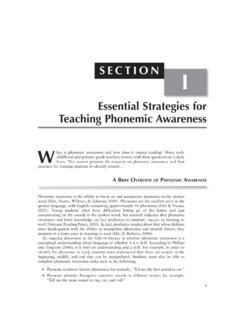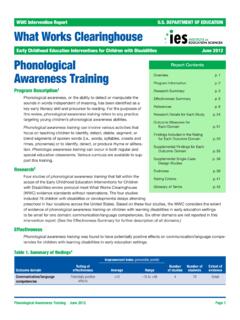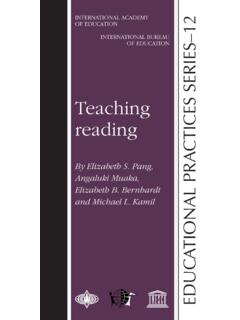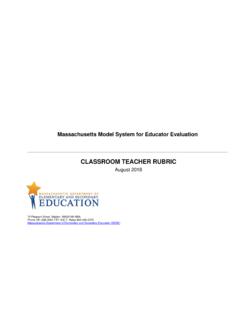Transcription of Theoretical Review of Phonics Instruction for Struggling ...
1 PASAA Volume 48 July - December 2014 Theoretical Review of Phonics Instruction for Struggling /Beginning Readers of English Pragasit Sitthitikul Thammasat University Abstract Learning to read is a complex task for beginners of English. They must coordinate many cognitive processes to read accurately and fluently, including recognizing words, constructing the meanings of sentences and text, and retaining the information read in memory. An essential part of the process for beginners involves learning the alphabetic system, including, letter-sound correspondences and spelling patterns, and learning how to apply this knowledge in their reading (National Reading Panel, 2000). Systematic Phonics Instruction is a way of teaching reading that stresses the acquisition of letter-sound correspondences and their use to read and spell words (Harris & Hodges, 1995).
2 Although Phonics Instruction is primarily designed for L1 beginners in the primary grades and for children having difficulty learning to read, it can be applied to L2 learners to make use of sound-symbol, vocabulary, and meaning to decode and comprehend texts (Bernhardt, 2000). This paper reviews critical notions in regard to Phonics Instruction in order to 114 | PASAA Vol. 48 (July - December 2014) provide sufficient background information for those new in this topic. Some useful pedagogical instructions are also presented, which could be applied to L2 learners. Keywords: Phonics Instruction , Struggling /beginning readers, phonemic awareness, phonological awareness Theoretical Basis The recent years acrimonious debate about beginning reading Instruction , especially at the first-grade level, is consistent with a half century of dispute about what works best in developing young readers (Adams, 1990; Chall, 1967).
3 Much of the current first grade debate has been between those who favor explicit Instruction of beginning reading skills, especially the teaching of Phonics , and those who favor an approach playing down systematic Instruction in favor of immersion in literacy tasks, the whole language philosophy. Those who favor a skills Instruction emphasis can point out to demonstrations in true experiments that intense teaching of decoding skills to children experiencing difficulties with word recognition increases their performance on standardized measures of word recognition or reading. In education, particularly, in the teaching of reading over the years, the choice of Instruction methods has been heavily influenced by many factors, not only teachers own frontline experiences about what works, but also politics, economics, and the popular wisdom of the day (National Reading Panel, 2000).
4 Meanwhile, substantial scientific evidence has accumulated purporting to shed light on reading acquisition processes and effective instructional approaches (Adams, 1990; Snow, Burns, & Griffin, 1998). Today, Phonics Instruction receives much attention when educators discuss the ingredients of effective programs to teach children to read. Research of more than two decades has affirmed PASAA Vol. 48 (July - December 2014) | 115 the importance of phonological awareness and its relation to reading acquisition. Reviews of the literature (Hurford, Darrow, Edwards, Howerton, Mote, Schauf, & Coffey, 1993) indicated that the presence of phonological awareness is a hallmark characteristic of good readers while its absence is a consistent characteristic of poor readers. In short, difficulties with awareness, coding, and retrieval of verbal sounds have powerful and long-reaching effects in reading.
5 However, the most encouraging lines of research give strong evidence that significant gains in phonological awareness can be achieved with teaching and that the gains in phonological awareness directly affect the ease of reading acquisition and subsequent reading achievement (Smith, Simmons, & Kameenui, 1998). It is thus important and interesting to Review Phonics Instruction so that reading teachers will learn more out of it and determine whether this Instruction lives up to these claims. From this article, readers will identify circumstances that govern its effectiveness to base the information as a stepping stone to extend it for possible future research projects. Moreover, there are additional reasons why Phonics Instruction is selected for Review in this project. Many studies investigating the effectiveness of phonemic awareness Instruction have contributed to this body of evidence.
6 Proponents believe that this research holds promise of placing reading Instruction on a more solid footing and ending the periodic upheavals and overhauls of reading instructional practices (National Reading Panel, 2000). According to the report of the National Reading Panel (2000), correlational studies have identified phonemic awareness and letter knowledge as the two best school-entry predictors of how well children will learn to read during their first 2 years in school. This evidence suggests the potential instructional importance of teaching phonemic awareness to children. In addition, many experimental studies have evaluated the effectiveness of phonemic awareness Instruction in 116 | PASAA Vol. 48 (July - December 2014) facilitating reading acquisition. Results are claimed to be positive and to provide a scientific basis documenting the efficacy of phonemic Instruction (National Reading Panel, 2000).
7 Although these studies are basically related to reading in L1, prior research shows that when L1 and L2 learners learn a second language, they use similar strategies when they read (Gass, & Selinker, 2001). To illustrate, they appear to make use of sound-symbol, vocabulary, meaning, language structure and background and textual knowledge to decode and comprehend texts (Bernhardt, 2000). The above information describes the broad concept of the evolution of Phonics Instruction . However, more details of the Theoretical basis of the technique will also be discussed throughout this report. Definitions of Important Terms Phonics Phonics has been called one among many cues used in reading ( , Dahl, Sharer, Lawson, & Grogran, 1999). It refers to instructional practices that emphasize how spellings are related to speech sounds in systematic ways (Snow, Burns, & Griffin, 1998).
8 By this definition, Phonics Instruction is found in many different types of reading programs (Routman, 1998). Stahl (2001) defines Phonics Instruction as any approach in which the teacher does/says something to help children learn how to decode words. This may involve teaching sound-symbol correspondences directly, having children manipulate sounds in written words through spelling tasks, pointing out patterns in similarly spelled words, or anything else which helps children learn about orthographic patterns in written language. Common forms of Phonics Instruction in the 1960s included synthetic Phonics Instruction , analytic Instruction , and linguistic readers (Aukerman, 1981). By the 1990s, there were new approaches to Phonics Instruction , PASAA Vol. 48 (July - December 2014) | 117 based on constructivist principles.
9 These approaches spelling-based approaches such as Making Words (Cunningham & Cunningham , 1998) or Word Study (Bear, Templeton, Invernizzi, & Johnston, 1996), embedded Phonics approaches (Hiebert, Colt, Catto, & Gary, 1992), and compare/contrast or analogy-based approaches all involved children in active construction of knowledge about orthographic patterns. Phonemes/ Phonemic Awareness According to the National Reading Panel (2000), phonemes are the smallest units constituting spoken language. English consists of about 41 phonemes. Phonemes combine to form syllables and words. A few words have only one phoneme, such as a or oh. Most words consist of a blend of phonemes, such as go with two phonemes, or check with three phonemes, or stop with four phonemes. Phonemes are different from graphemes, which are units of written language and which represent phonemes in the spellings of words.
10 Graphemes may consist of one letter, for example, P, T, K, A, N, or multiple letters, CH, SH, -CK, EA, -IGH, each symbolizing one phoneme. Snow, Burns, and Griffin (1998) define phonemes as the speech phonological units that make a difference to meaning. Thus, the spoken word rope is comprised of three phonemes: /r/, /o/, and /p/. It differs by only one phoneme from each of the spoken words, soap, rode, and rip. Phonemic awareness refers to the ability to focus on and manipulate phonemes in spoken words. Phonemic awareness is the insight that every spoken word can be conceived as a sequence of phonemes. Because phonemes are the units of sound that are represented by the letters of an alphabet, an awareness of phonemes is key to understanding the logic of the alphabetic principle and thus to the learnability of Phonics and spelling (Snow, Burns, & Griffin,1998).
















